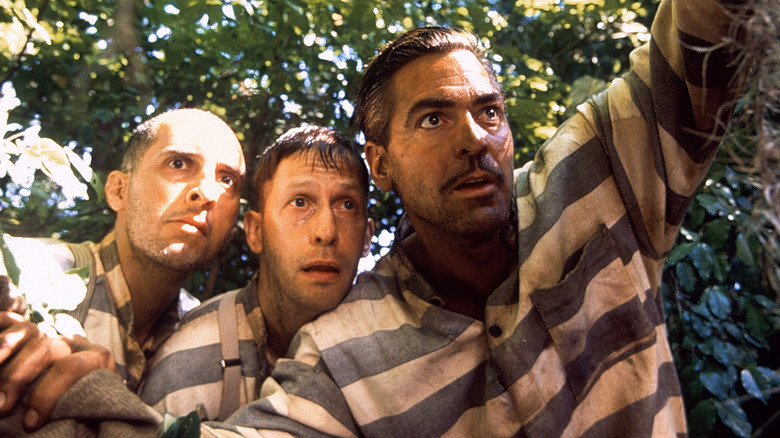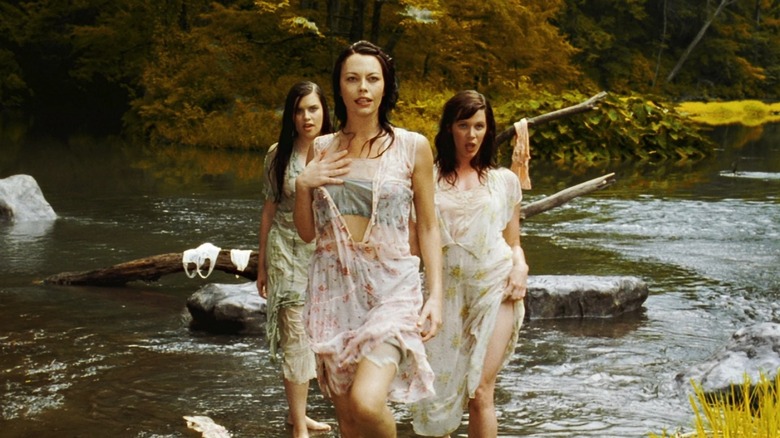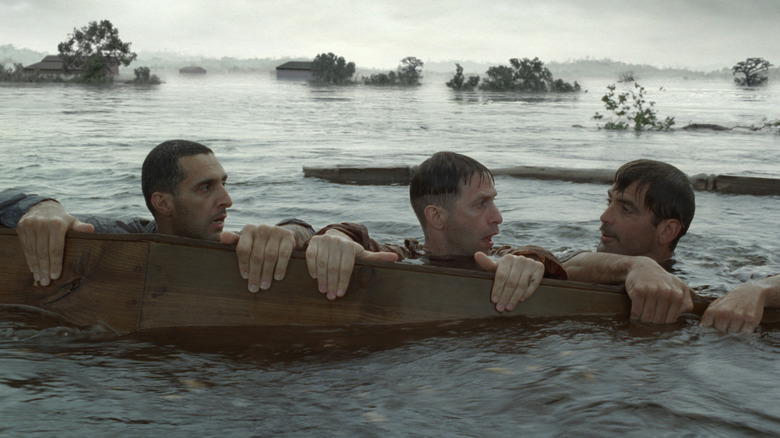The Coen Brothers Originally Based O Brother, Where Art Thou? On A Classic Movie Musical
Joel & Ethan Coen's 2000 film "O Brother, Where Art Thou?" draws inspiration from many sources, the foremost of which is probably "The Three Stooges." In the film, George Clooney, Tim Blake Nelson, and John Turturro play a trio of escaped chain gang convicts in late 1930s Mississippi. Ulysses Everett McGill (Clooney), is the forward-thinking intelligent character with impeccable hair (he's Larry), with Turturro playing the tough, strong-willed one (he's Moe), and Nelson playing the blissfully unaware one (he's Curly).
Indeed, in an interview with IndieWire for the film's 15th anniversary, Joel Coen described the initial concept for "O Brother" as being merely "three saps on the run," a description that sounds like the title of a "Three Stooges" short unto itself. The ultimate title is borrowed from the 1941 Preston Sturges comedy "Sullivan's Travels." As the writing continued, however, both Joel & Ethan Coen began to realize that "O Brother" was very much becoming a 1930s-era version of Homer's 8th century BC epic poem "The Odyssey."
Prior to this realization, however, the goal was to make "O Brother" look more like another classical Hollywood film: "The Wizard of Oz." Indeed, subtract Dorothy from the equation, and you have a trio of saps — a lion who shrinks form danger, an unthinking scarecrow, and a sensitive tin man — on a quest through a bizarre and dangerous territory.
There's no place like home
The structure of "The Wizard of Oz" is, of course, a common traditional "quest" formula commonly seen in movies. A character has to leave their comfort zone to quest across a dangerous land, only to find something vital about themselves at the end. That's a lesson from Screenwriting 101. Indeed, more ambitious essayists can extend "The Wizard of Oz" structure back to the oldest story currently known by humanity, the Epic of Gilgamesh, first written in Akkadian in around 2100 BCE. In both stories, the hero (Gilgamesh, Dorothy) go on a quest to find a magical object (a fountain of youth, the means to return to Kansas) but find that the quest was more important than the object, and the magic is absconded by a snake (a snake, Professor Marvel).
The Coens didn't reach back as far as Gilgamesh, but they eventually take inspiration from an epic poem that was, without question, influenced by Gilgamesh (if you have read M.L. West's "The East Face of Helicon: West Asiatic Elements in Greek Poetry and Myth," you know what we're talking about). They ended up settling on "The Odyssey." Coen explained:
"It didn't start with that idea. It started as a 'three saps on the run' kind of movie, and then at a certain point we looked at each other and said, 'You know, they're trying to get home — let's just say this is "The Odyssey."' We were thinking of it more as 'The Wizard of Oz.' We wanted the tag on the movie to be: 'There's No Place Like Home.'"
The Odyssey
Once the screenplay was finished, however, the Coens has openly accepted that their movie was based on "The Odyssey," even go so far as to give Homer a credit. The parallels are myriad: Ulysses is on a quest to return to his wife Penelope (Holly Hunter) after an absence, all while a suitor (Ray McKinnon) lies in wait. Ulysses is tempted by sirens. Ulysses and his men encounter an evil cyclops (John Goodman). There is a blind seer (Lee Weaver). There are even Poseidon and Zeus analogues in the Daniel von Bargen and Charles Durning characters, respectively. One might even say that the blind radio manager played by Stephen Root could be a stand-in for Homer himself.
In the same IndieWire anniversary retrospective, Nelson recalls how much the Coens had begun to roll with the "Odyssey" thing during screenwriting, having seen a copy of the book on their bookshelf when he had come to visit one day:
"I guess they were writing it because there was a copy of the fable's translation — which was the new translation [Likely Robert Fagles' 1990 translation] — and there was a Post-it on top of it and it said: 'Soon to be a motion picture by Joel and Ethan Coen.'"
"The Wizard of Oz" was a good place to start, but the Coens ended up reaching back to L. Frank Baum's own literary antecedents to make "O Brother." They must have done something right, as the 2000 film was their biggest hit up to that point (it made over $71 million at the box office, and that's nothing to say of it's overwhelmingly popular soundtrack record), and was nominated for two Academy Awards, including for its screenplay.
"O Brother, Where Art Thou?" had a happier ending than Homer's epic, which ended with the words: "The Sun has been obliterated from the sky, and an unlucky darkness invades the world."


